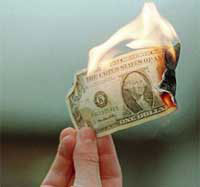Dollar setback undermines Russia's financial basis
Since July 2006, when a certain part of Russia’s Stabilization Fund was converted into dollars, the setback of the U.S. currency devalued the fund at about four billion dollars.

If we compare this money with the population of Russia – 142 million people - it turns out that every Russian citizen loses $28. This appears to be matter of great importance taking into consideration the fact that the minimum wage in Russia makes up about $100.
At a recent panel discussion of the Budget Committee of the Federation Council, Senator Andrey Vavilov proposed to invest the money of the Stabilization Fund in foreign companies’ shares through special funds. Many support this idea. But the matter still remains in the verbal form only. It may be high time for Russia to change the dollar policy of the Stabilization Fund.
Pros:
Alexei Mamontov, the President of Moscow International Currency Association:
“The Ministry of Finance distributed Stabilization Fund means among currency baskets quite correct. Notwithstanding the declining dollar rate, the American economy remains the leading economy on the global market, and its currency is still reliable. American goods and services account for at least a quarter of the world GDP (for comparison: Russia’s GDP accounts to only eight or nine percent of the U.S. GDP).
The declining dollar rate is not so dramatic therewith. As for the low profitability of deposits and securities (three or four percent per annum), in which the Finance Ministry invested in, these funds are not meant for the commercial use. The Government pursues the only goal: to preserve the money. That is why it deposits in conservative banks. The risk there is minimal, but we should pay for this security.”
Cons:
Michael Delyagnin, the Director of the Institute of Globalization Problems:
“The share of the dollar in the Stabilization Fund of Russia can be reduced. Firstly it can be decreased by 30 percent. The released 15 percent could be spent as follows: ten percent on the Chinese yuan and five percent on the Japanese yen. The yuan is formally inconvertible. But the Chinese economy is the most successful one in the world. It is supposed to develop dynamically in future. Major Western investors invest in China now. It should give a signal to Russia. We should see which Chinese assets are worth investing in now.
Of course, we can not at once remove money from the Stabilization Fund, because it is transferred on deposits in American banks and invested into the US Treasury securities, and we have certain commitments. But on the other hand, maybe it’s preferable to pay fines as we did last year to liquidate the external debt? Then it would be possible to convert new proceeds in the Stabilization Fund into other currencies instead of dollars.”
April of 2006 saw the epochal decision to convert oil superprofits into foreign currency. It was then that the government distributed the funds among currency baskets: 45 percent was converted into U.S. dollars, 45 percent - into euro and ten percent - into pounds sterling.
Arguments and Facts
Translated by Ksenia Sedyakina
Pravda.ru
Subscribe to Pravda.Ru Telegram channel, Facebook, RSS!




